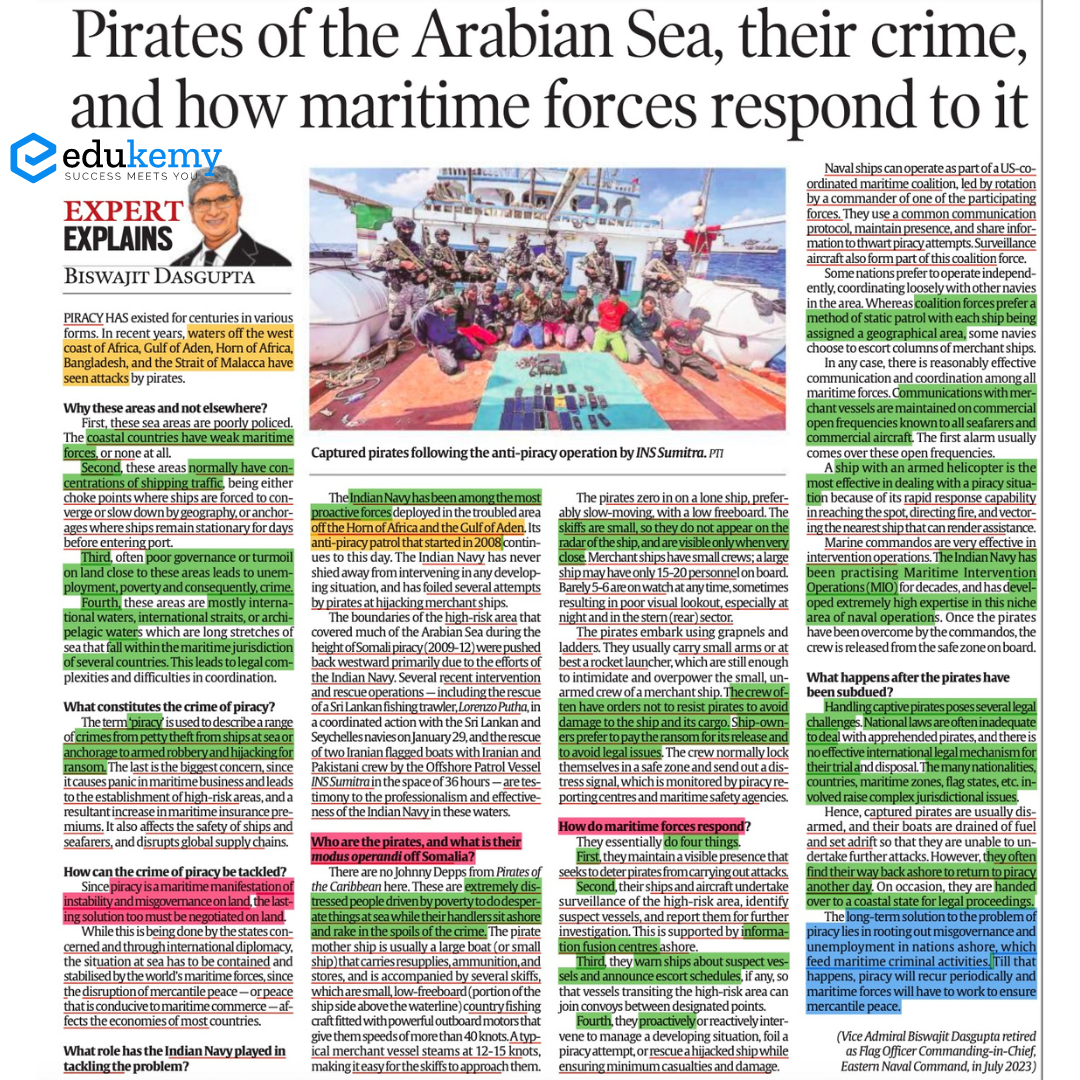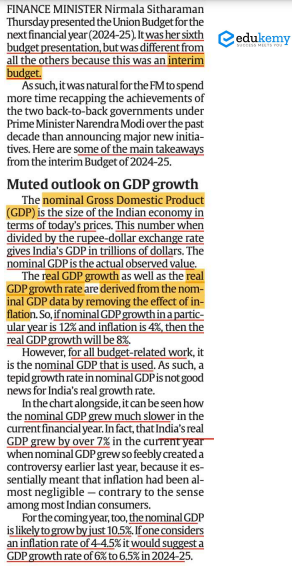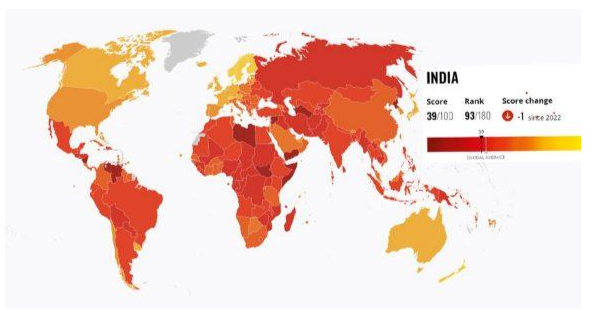Monday, 5th February 2024
Daily News Paper Snippets - 05th February 2024
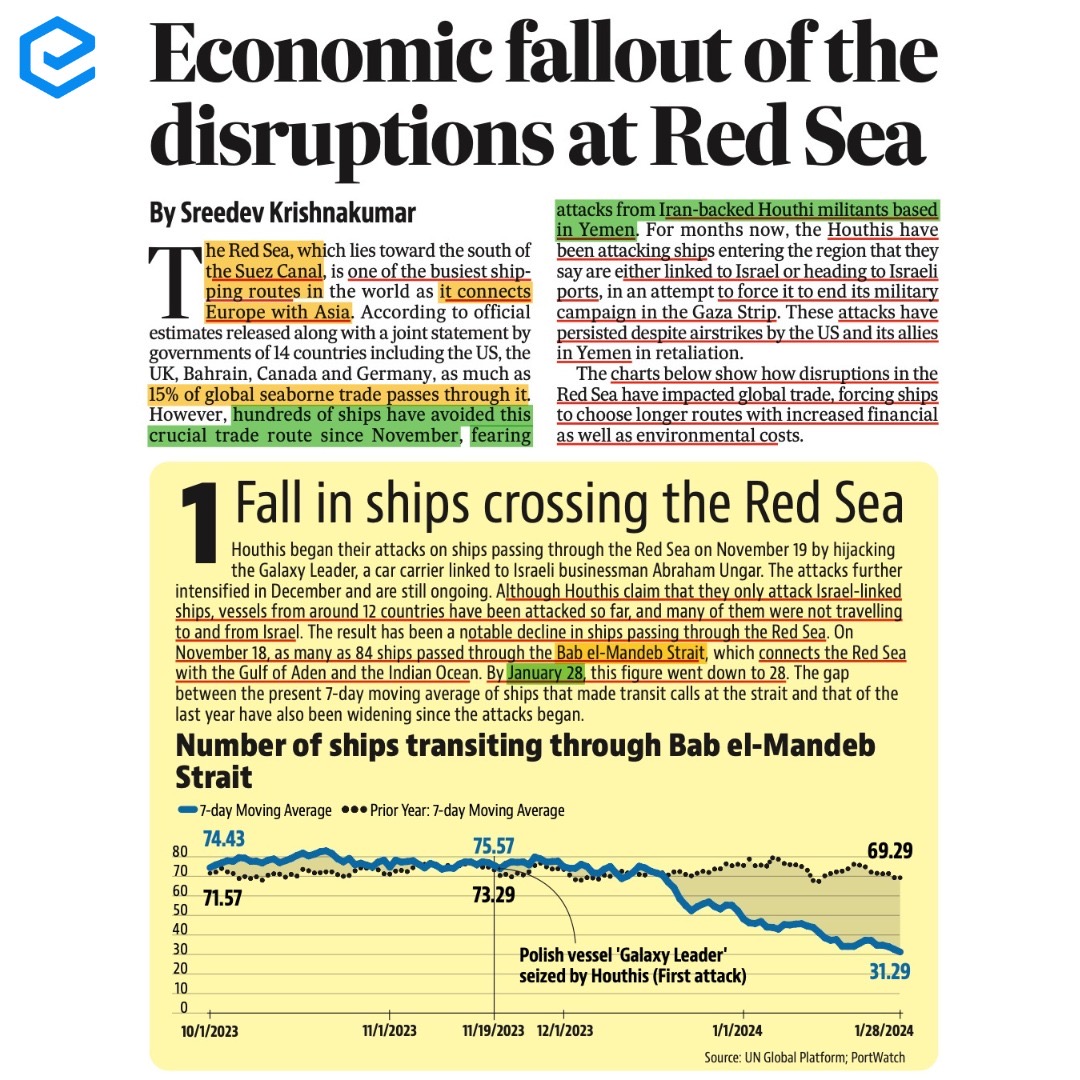
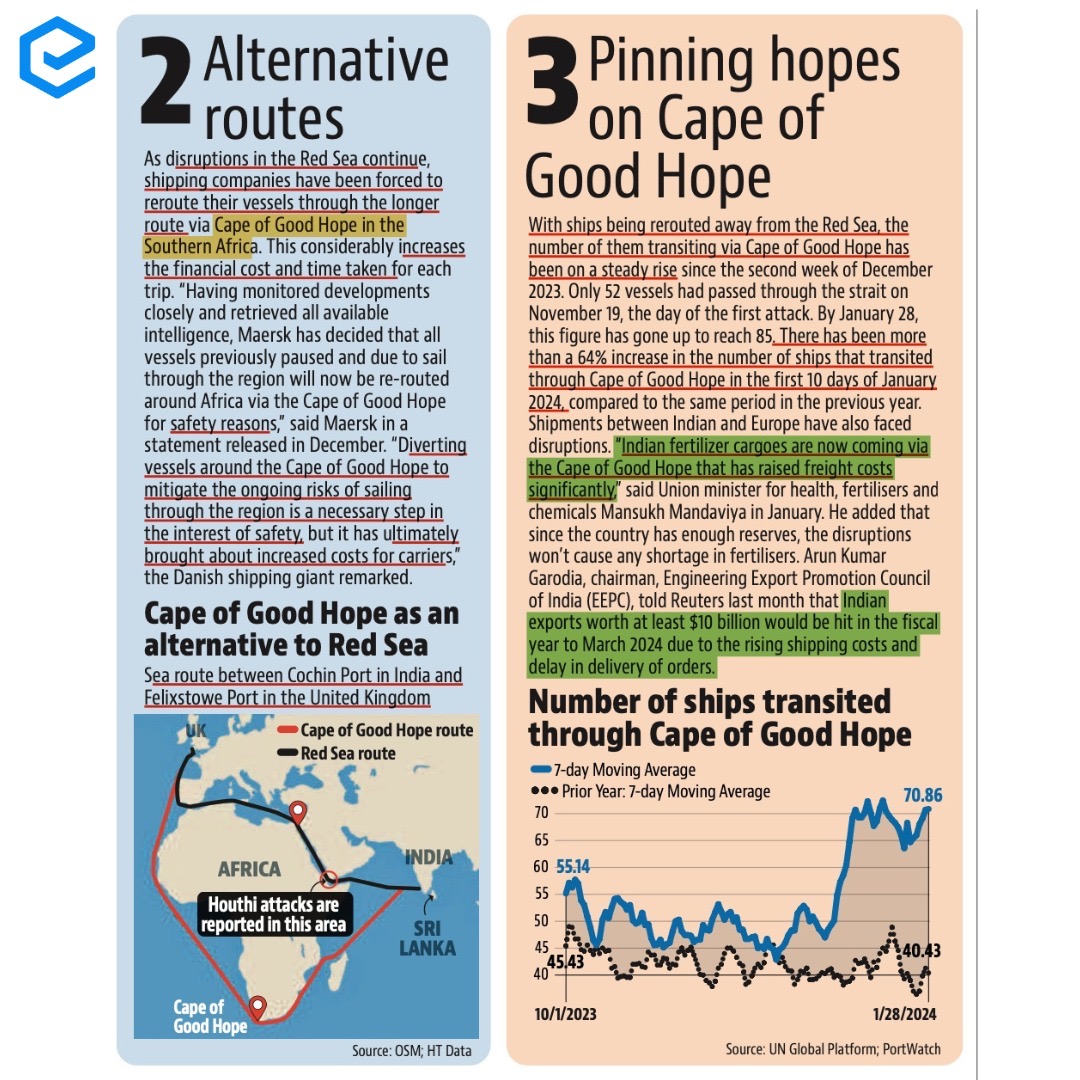

National Conference on Promotion of Seaweed Cultivation
In News: The Koteshwar (Kori Creek), Kutch, Gujarat, hosted the National Conference on the Promotion of Seaweed Cultivation in a recent gathering.
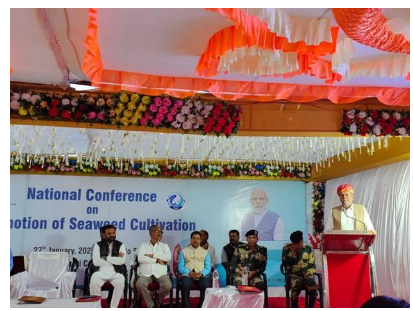
Introduction to Seaweeds
- Seaweeds are macroscopic, multicellular marine algae, exhibiting a spectrum of colors including red, green, and brown.
- Recognized as the 'Medical Food of the 21st Century,' they thrive in various marine environments, from intertidal regions to deep-sea habitats and estuaries.
Distribution and Habitat
- Seaweeds predominantly inhabit intertidal zones, shallow and deep sea waters, as well as estuaries.
- Notable formations include kelp forests, acting as vital underwater nurseries for diverse marine life.
Seaweed Species in India
- India hosts approximately 844 reported seaweed species in its waters.
- Cultivated species like Gelidiella acerosa, Gracilaria spp., Sargassum spp., Turbinaria spp., and Cystoseira trinodis contribute to the production of valuable substances like agar, alginates, and liquid seaweed fertilizer.
Major Seaweed Beds in India
- Abundant seaweed resources are concentrated along the coasts of Tamil Nadu and Gujarat, as well as around Lakshadweep, Andaman & Nicobar Islands.
- Notable beds exist in Mumbai, Ratnagiri, Goa, Karwar, Varkala, Vizhinjam, and Pulicat.
Significance of Seaweeds
- Bio-indicator
- Seaweeds serve as bio-indicators, absorbing excess nutrients and signaling chemical damage in marine ecosystems.
- Food Source
- Rich in vitamins, minerals, and dietary fiber, seaweed is utilized in various food products, from sushi to snacks.
- Bioproducts
- Seaweed extracts find applications in cosmetics, pharmaceuticals, and bioplastics, offering sustainable alternatives.
- Carbon Capture
- Seaweed aids in carbon dioxide absorption, presenting a potential solution to combat climate change.
- Livelihoods
- Seaweed farming empowers coastal communities, providing income with minimal investment and quick returns.
Other Benefits and Applications
- Seaweeds find use in laxatives, pharmaceutical capsules, goiter treatment, cancer therapy, bone replacement, and cardiovascular surgeries.
- Historical evidence suggests potential ancient medicinal uses, such as in breast cancer treatment.
Government Initiatives
- Seaweed Mission
- Aiming to commercialize seaweed farming and processing for value addition along India's extensive coastline.
- Commercialisation of Seaweed Products
- The ICAR-CMFRI successfully commercialized nutraceutical products like CadalminTM Immunalgin and CadalminTM Antihypercholesterolemic extracts, promoting anti-viral immunity and combating high cholesterol.
Multi-Purpose Seaweed Park in Tamil Nadu
- Highlighting the establishment of a multi-purpose seaweed park in Tamil Nadu, fostering research, development, and commercialization to harness the full potential of seaweed resources.
Source: PIB
Rs 1 Lakh Crore Corpus to Incentivise R&D in Private Sector
In News: As a notable step to encourage Research and Development (R&D) in the private sector, the Finance Minister, in the Interim Union Budget 2024-25, unveiled the creation of a financial corpus amounting to Rs 1 lakh crore.
Budget 2024-25 Announcement: Rs 1 Lakh Crore Corpus for Private Sector R&D Incentives
Introduction
- The recently announced budget for the fiscal year 2024-25 includes a significant allocation of Rs 1 Lakh Crore aimed at incentivizing Research and Development (R&D) in the private sector.
Objectives of the Corpus
- Low-Cost or Zero-Interest Loans: The corpus is designed to provide low-cost or zero-interest loans to facilitate research and innovation in the private sector.
- Long-Term Financing Facility: Private companies can avail interest-free loans for up to 50 years, providing a long-term financing or refinancing facility through this innovative mechanism.
- Encouraging Innovation in Sunrise Domains: The initiative is expected to encourage private sector entities to scale up research and innovation significantly, particularly in sunrise domains.
Alignment with Government Initiatives
- The establishment of this new fund aligns with the government's ongoing efforts to foster private sector involvement in research activities.
- Notably, the government had set up the National Research Foundation (NRF) last year.
Overview of NaBFID (National Bank for Financing Infrastructure and Development)
- Specialized Development Finance Institution: NaBFID serves as a specialized Development Finance Institution (DFI) in India, focusing on supporting the country's infrastructure sector.
- Establishment: Founded in 2021 through an Act of Parliament, the National Bank for Financing Infrastructure and Development Act, 2021.
- Objectives: NaBFID aims to address gaps in long-term non-recourse finance for infrastructure development, strengthen bonds and derivatives markets, and sustainably boost the country's economy.
Insights into NIIF (National Investment and Infrastructure Fund)
- Government-Backed Sovereign Wealth Fund: NIIF is a government-backed quasi-sovereign wealth fund, with a 49% government stake and the rest held by foreign and domestic investors.
- Establishment: Set up in 2015 and registered with SEBI as a Category-II Alternative Investment Fund (AIF).
Govt's Plan for Operationalizing Rs 1 Lakh Crore Corpus Fund through Financial Institutions
- Project Success Rate Consideration: Acknowledging the potentially low success rate and long gestation periods for some projects, the government is contemplating long-duration loans of up to 50 years with zero interest to financial institutions.
- Operational Mechanism: Financial institutions may receive these loans and, in turn, provide credit at nil or concessional rates for refinancing or directly financing commercial ventures.
- Commercial Funding for Innovation: The allocated Rs 1 Lakh Crore is designated for commercial, for-profit ventures, specifically those involving innovative and cutting-edge technologies.
- Enabling Ecosystem: The government aims to create an enabling ecosystem for ventures in emerging technologies to thrive.
- Sector Considerations: Inter-ministerial deliberations are underway to determine the sectors eligible for funding under this initiative.
- Project Allocation: The Rs 1 Lakh Crore corpus will be distributed over the years for various projects, with decisions potentially made by an expert committee.
Source: IE
Gentoo Penguins
In News: In a recent incident, more than 200 Gentoo penguins were discovered deceased in the Falkland Islands, Antarctica, as a result of the H5N1 Avian Influenza Virus spreading.
Avian Influenza: Understanding the Virus
Overview
- Avian influenza, commonly known as bird flu, is a highly contagious viral infection primarily affecting birds, both wild and domestic. The emergence of the H5N1 virus in 1996 marked a significant development, particularly in Southern China.
Transmission to Humans and Symptoms
- Human Cases: While human cases of H5N1 avian influenza are infrequent, person-to-person transmission is challenging.
- Symptoms: Ranging from mild flu-like symptoms to severe respiratory issues, the mortality rate, as per the World Health Organization (WHO), is approximately 60%.
Avian Influenza in India
- Initial Outbreak: The first outbreak in India occurred in 2006 in Navapur, Maharashtra, followed by annual occurrences.
- H5N8 Observations: H5N8 was first detected in India in November 2016, mainly affecting wild birds across five states, with Kerala reporting the highest number of cases.
- Nationwide Impact: Reported in 24 states and union territories, leading to the culling of over 9 million birds.
- India's Approach: Follows a "detect and cull" policy outlined in the National Action Plan for Prevention, Control, and Containment of Avian Influenza (revised - 2021).
Treatment
- Antivirals: Effective in treating avian influenza virus infections in humans, reducing severity and the risk of death.
Key Facts About Gentoo Penguins: Understanding a Unique Species
- Scientific Name: Pygoscelis papua
- Distinctive Features: Characterized by a white band above each eye, a black throat, a prominent brush tail, and a mostly deep orange or red bill.
- Distribution: Exclusively found in the Southern Hemisphere, particularly on the Antarctic Peninsula and various sub-Antarctic islands, with a significant presence in the Falkland Islands.
- Habitat: Typically situated along shorelines, strategically positioning themselves for efficient foraging and nesting while staying close to their nests.
- Threats:
- Predators: Vulnerable to predation by various marine and avian species.
- Human Impact: Historical practices such as egg collection and harvesting of skins and blubber.
- Environmental Changes: Changing conditions and competition with humans for prey may impact population sizes.
- Conservation Status: Least Concern on the IUCN Red List.
|
UPSC Previous Year Questions Prelims (2015) Q. H1N1 virus is sometimes mentioned in the news with reference to which one of the following diseases? (a) AIDS Ans: (d) |
Source: DTE
Brainoware
In News: In a recent breakthrough, scientists have successfully fused brain-like tissue with electronics, giving rise to Brainoware—an 'organoid neural network (ONN)' proficient in voice recognition and adept at solving intricate mathematical problems.
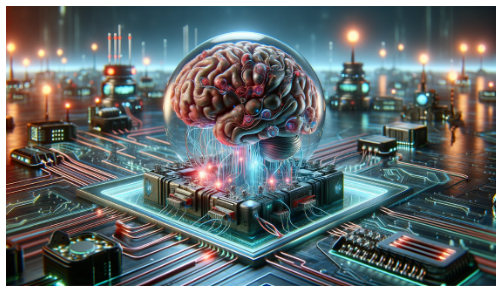
Brainoware: Merging Living Tissue with Electronics in Innovative Computing
Introduction
Brainoware represents a cutting-edge computing system that combines brain-like tissue with electronics, introducing an unconventional approach to information processing.
Integration of Brain Organoids and Microelectrodes
- Organoid Neural Network (ONN): Brainoware pioneers the integration of brain organoids with microelectrodes, forming an ONN that directly involves living brain tissue in the computing process.
- Brain Organoids: These 3D tissues, derived from human embryonic stem cells, simulate the structure and function of the human brain, self-organizing and reflecting developmental processes.
Distinguishing Features of ONNs
- Biological Neurons: ONNs differ from artificial neural networks, utilizing biological neurons capable of adaptation and learning from their environment.
- Operational Mechanism: Characterized by a three-layered architecture - Input, Reservoir, and Output.
Operational Mechanism of Brainoware
- Input Signals Processing: ONNs process electrical stimulation as input signals, unique in utilizing biological neurons for this function.
- Reservoir: Acting as a black-box, the reservoir converts signals into mathematical entities for efficient computer processing, eliminating constant data transfer.
- Output Readout: The modified conventional computer hardware interprets Brainoware's neural activity, providing tangible results.
Advantages over Traditional Neuromorphic Computing
- Memory and Processing Separation: Addressing the challenge in traditional neural networks, Brainoware integrates biological neural networks where memory and data processing occur together, reducing time and energy demands.
- Biological Neural Network Integration: Live brain cells in Brainoware result in significantly lower energy consumption compared to AI hardware, eliminating the need for separate memory units.
Challenges and Considerations
- Technical Challenges: Maintenance of a biological neural network requires technical expertise and infrastructure.
- Ethical Concerns: The use of organoids raises ethical questions regarding consciousness and their mechanistic utilization.
Future Prospects of Brainoware
- Learning Mechanisms: Ongoing study of the ONN provides foundational insights into learning mechanisms.
- Neuroscience Advancements: Brainoware contributes to neuroscience and medical research, exploring cognitive implications of neurodegenerative diseases.
- Intersection of Disciplines: Uniting tissue engineering, electrophysiology, and neural computation, Brainoware opens possibilities for future advancements.
Source: TH
The C-CARES web portal
In News: The C-CARES web portal of the Coal Mines Provident Fund Organization (CMPFO) was recently launched by the Ministry of Coal (MoC).
About C-CARES web portal
- The Centre for Development of Advanced Computing (C-DAC), a Research and Development organization under MeitY, has developed the C-CARES web portal.
- C-CARES, established by the Centre for Development of Advanced Computing, aims to revolutionize record-keeping and streamline processes for subscribers and pensioners of the Coal Mines Provident Fund Organization (CMPFO).
- CMPFO, an autonomous organization under the Ministry of Coal, administers Provident Fund and Pension schemes for social security within the coal sector.
- Currently, CMPFO provides services to approximately 3.3 lakh Provident Fund subscribers and 6.1 lakh pensioners in the coal sector.
- C-CARES offers a range of functionalities tailored to the needs of CMPF subscribers and coal companies.
- These functionalities include online settlement of claims, paperless working, ensuring timely and accurate settlement of claims, reducing processing time, and facilitating effective grievance redressal.
- The introduction of C-CARES signifies a digital transformation that aligns with the broader vision of Digital India.
Source: PIB
Digital Detox Initiative for Responsible Tech Use
In News: In partnership with the All India Game Developers Forum (AIGDF), the Government of Karnataka is poised to introduce a Digital Detox initiative focused on gaming and social media.
About Digital Detox Initiative
- Digital Detox Centers will be established in Karnataka to provide personalized guidance, counseling, and practical tools for effective screen time management.
- These centers aim to offer support in addressing the challenges associated with excessive use of digital devices.
- The initiative is a response to the growing concern about the impact of prolonged screen time on mental health and overall well-being.
- AIGDF, a not-for-profit collective affiliated with the All India Gaming Federation (AIGF), is taking the lead in establishing these Digital Detox Centers.
- The All India Gaming Federation recognizes the need to address the evolving landscape of digital engagement and its potential impact on individuals' mental and emotional health.
- The Indian gaming market is anticipated to witness substantial growth, projecting an increase from USD 2.8 billion in 2022 to USD 5 billion in 2025.
- The establishment of Digital Detox Centers aligns with the proactive approach to promote a healthy balance in digital consumption and mental wellness.
Source: HT
Vessel Sandhayak
In News: The commissioning of the latest Survey Vessel Sandhayak (Y-3025) by the Indian Navy is imminent, scheduled to take place at the Naval Dockyard in Visakhapatnam, Andhra Pradesh.
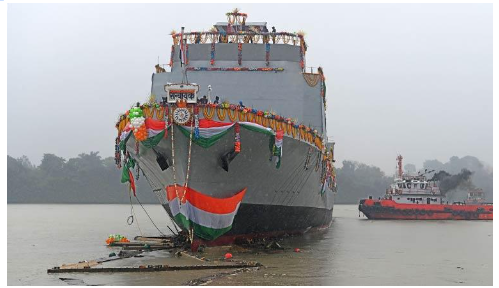
About Vessel Sandhayak
- The primary function of the ship is to conduct comprehensive hydrographic surveys, covering ports, harbors, navigational channels/routes, coastal areas, and deep seas.
- These surveys play a crucial role in ensuring safe marine navigation by providing accurate and up-to-date information.
- In its secondary capacity, the ship is designed to carry out a variety of naval operations, enhancing its versatility.
- Equipped with advanced hydrographic tools, Sandhayak features a Deep & Shallow Water Multibeam Remotely Operated Vehicle, Side Scan Sonars, Data Acquisition and Processing System, satellite-based positioning systems, and terrestrial survey equipment.
- The inclusion of such cutting-edge technology underscores the ship's capability to fulfill its primary role effectively.
- Sandhayak stands as a testament to India's shipbuilding capabilities, boasting an impressive 80% indigenous content.
- This commitment to self-reliance aligns seamlessly with the nation's overarching vision of Aatma Nirbhar Bharat.
Source: HT
Nano DAP
In News: In the interim budget presentation, the Finance Minister of India recently declared the broadening of Nano DAP's application to encompass various crops across all agro-climatic zones.
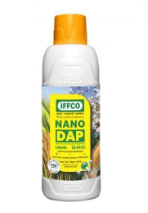
Nano DAP: Revolutionizing Crop Nutrition
Overview
Nano DAP is an innovative liquid fertilizer containing nanoparticles of Diammonium Phosphate (DAP), serving as a vital source of nitrogen and phosphorus, two key primary nutrients crucial for crop growth.
Key Features
- Nutrient Composition: Nano DAP comprises 8% Nitrogen and 16% Phosphorus by volume, providing a balanced nutrient profile.
- Physical Form: Unlike traditional granular DAP, Nano DAP is presented in liquid form, offering unique advantages in terms of surface area to volume ratio.
- Particle Size: With a particle size less than 100 Nanometres (nm), Nano DAP boasts a superior surface area, enhancing nutrient availability.
Advantages of Nano DAP
- Higher Crop Yield: Seed treatment and foliar application of Nano DAP at critical growth stages contribute to increased nutrient availability, resulting in higher crop yields.
- Quality Food: Harvested food produce exhibits improved nutritional quality, particularly in terms of protein and nutrient content.
- Reduced Fertilizer Usage: Enhanced efficiency allows for potential replacement of conventional DAP by 50%, making Nano DAP a sustainable and resource-efficient option.
- Environment Friendly: Precision application minimizes environmental impact, reducing soil, air, and water pollution, contributing to sustainable agriculture.
- Cost-Effective: Nano DAP is more economically viable than its conventional counterpart, with a 500 ml bottle equivalent to a 50-kg bag of traditional DAP.
- Import Reduction: The widespread adoption of Nano DAP is expected to significantly decrease the dependency on imported fertilizers, promoting self-sufficiency in agriculture.
Conclusion
Nano DAP emerges as a game-changer in the agricultural sector, not only for its efficiency in nutrient delivery but also for its positive impact on crop yield, food quality, and environmental sustainability.
Source: IE
Inclusive Education for Disabled at Secondary Stage (IEDSS) Scheme
In News: The Karnataka government has suspended five officers for neglecting their duties in implementing the Inclusive Education for Disabled at Secondary Stage (IEDSS) scheme.
Inclusive Education for Disabled at Secondary Stage (IEDSS) Scheme: Enhancing Access to Education
- Overview
- The Inclusive Education for Disabled at Secondary Stage (IEDSS) scheme, initiated in 2009-10, replaces the Integrated Education for Disabled Children (IEDC) scheme, focusing on facilitating a conducive learning environment for students with disabilities in the secondary stage.
- Aim
- Enable students with disabilities to pursue four years of secondary education in an inclusive and supportive setting after completing eight years of elementary schooling.
- Coverage
- The scheme encompasses students in classes IX to XII, studying in Government, local body, and Government-aided schools.
- Disabilities covered include blindness, low vision, leprosy cured, hearing impairment, locomotory disabilities, mental retardation, mental illness, autism, cerebral palsy, and potentially speech impairment, learning disabilities, etc.
- Special Focus on Girls
- Girls with disabilities receive special attention, aiming to provide them access to secondary schools along with information and guidance for unlocking their potential.
- Model Inclusive Schools
- The scheme envisions the establishment of Model Inclusive Schools in every state.
- Components
- Student-oriented Components
- Medical and educational assessment
- Books and stationery
- Uniforms
- Transport allowance
- Reader allowance
- Stipend for girls
- Support services
- Assistive devices
- Boarding and lodging facilities
- Therapeutic services
- Teaching-learning materials, etc.
- Other Components
- Appointment of special education teachers
- Allowances for general teachers for teaching such children
- Teacher training
- Orientation of school administrators
- Establishment of resource rooms
- Providing a barrier-free environment, etc.
- Student-oriented Components
- Implementing Agency
- The School Education Department of State Governments/Union Territory Administrations serves as the implementing agency.
- Collaboration with NGOs experienced in the education of disabled individuals is encouraged.
- Financial Assistance
- Central assistance covers all aspects of the scheme on a 100 percent basis.
- State governments are required to provide a scholarship of Rs. 600 per disabled child per annum.
- Subsumed under RMSA
- The scheme has been subsumed under the Rashtriya Madhyamik Shiksha Abhiyan (RMSA) since 2013.
Source: TH
Indian Renewable Energy Development Agency Limited (IREDA)
In News: IREDA, in collaboration with its knowledge partner Boston Consulting Group (BCG), recently organized a Strategic Meeting to discuss vital aspects of business expansion and initiatives targeted at reducing costs in fund utilization.
Indian Renewable Energy Development Agency Limited (IREDA): Fostering Sustainable Energy Solutions
- Overview
- IREDA is a Mini Ratna (Category–I) non-banking financial institution operating under the Ministry of New and Renewable Energy (MNRE).
- Established in 1987, it functions as a Public Limited Government Company and is registered as a Non-Banking Financial Institution (NBFC) with the Reserve Bank of India (RBI).
- IREDA holds the status of a “Public Financial Institution” under Section 4 ‘A’ of the Companies Act, 1956.
- Primary Focus
- Engaged in promoting, developing, and extending financial assistance for projects related to new and renewable energy sources and energy efficiency/conservation.
- Key Features
- Recognized as the single largest "Green Financier" in the country.
- Covers all technologies in the renewable energy sector, primarily providing financing for the sector.
- Motto: ENERGY FOR EVER
- Objectives
- Financial Support: Provide financial support for specific projects and schemes focused on generating electricity through new and renewable sources and conserving energy via energy efficiency.
- Leading Organization: Maintain a leading position as an organization offering efficient and effective financing in renewable energy and energy efficiency/conservation projects.
- Increased Share: Enhance IREDA's share in the renewable energy sector through innovative financing approaches.
- Efficiency Improvement: Improve service efficiency by continually enhancing systems, processes, and resources.
- Competitive Institution: Strive for competitiveness by ensuring customer satisfaction.
- Funding
- IREDA generates revenue through interest and principal repayments from financed projects.
- Additional funding sources include raising funds from the market and through borrowings.
Source: PIB
Fencing Free Movement in India-Myanmar Relations
In News: A recent article explores the present challenges in diplomatic relations between India and Myanmar, analyzing the existing difficulties and suggesting possible solutions.
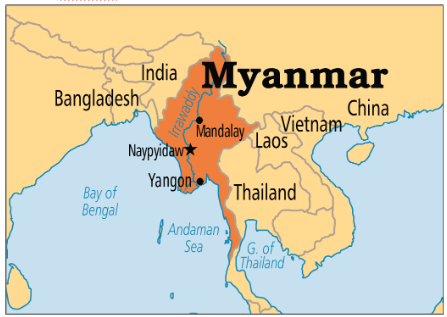
Significance of India-Myanmar Relationship
- Geopolitical Importance
- Gateway to Southeast Asia
- Myanmar serves as a land bridge connecting South Asia to Southeast Asia.
- Proximity to India's northeastern states establishes a strategic link, enhancing regional connectivity.
- Bay of Bengal Connectivity
- Maritime boundary in the Bay of Bengal fosters economic and strategic collaboration.
- Regional Power Balancing
- Strengthens India's position in the region, countering potential power imbalances from other major players.
- Gateway to Southeast Asia
- Strategic Significance
- Strategically Significant Neighbourhood
- Developments in Myanmar impact neighboring countries.
- Aligned with India's "Neighborhood First" policy.
- Act East Policy
- Integral to India's diplomatic initiative aimed at fostering relations in the Asia-Pacific region.
- Multilateral Engagement:
- Myanmar's memberships in regional organizations add regional dimensions to bilateral relations.
- Strategically Significant Neighbourhood
Areas of Collaborative Cooperation
- Bilateral Trade
- India ranks as Myanmar's fifth-largest trading partner, focusing on agriculture, pharmaceuticals, IT, and energy.
- Energy Cooperation
- Myanmar crucial for India's energy security, with significant investments in the oil and gas sector.
- Investment in Infrastructure
- Projects like the Kaladan Multi-Modal Transit Transport and India-Myanmar-Thailand Trilateral Highway.
- Strategic Defense Partnership
- Close defense ties, including joint exercises and capacity building.
- Capacity Building Measures
- Developmental assistance, support in disaster risk mitigation, and humanitarian aid.
- Cultural Connectivity
- Shared Buddhist heritage and colonial history strengthen cultural ties.
Key Issues in India-Myanmar Relationship
- Internal Security Concerns
- Vulnerable Borders
- Porous border exploited by insurgent groups, impacting the northeastern region.
- Free Movement Regime (FMR)
- Considerations to terminate FMR due to unintended consequences.
- Triangular Power Struggle
- Ongoing internal strife after the military coup poses challenges.
- Rohingya Crisis
- Humanitarian and human rights issues strain bilateral relations.
- Infrastructure Project Delays
- Prolonged delays in collaborative projects affect trust.
- China's Influence
- Challenges in mitigating China's influence in Myanmar.
- Vulnerable Borders
The Way Forward
- Strategic Diplomacy
- Better Regulation of FMR
- Manage movement effectively while preserving cross-border connections.
- Engage with Multiple Stakeholders
- Balance relations with the military government while involving various stakeholders.
- Balancing China's Influence
- Engage in strategic partnerships to counterbalance China's influence.
- Better Regulation of FMR
- Collaborative Instruments
- Promote Two-way Trade
- Diversify trade relations and explore opportunities for Myanmar to export more to India.
- Accelerate Infrastructure Projects
- Ensure timely completion of joint projects for enhanced connectivity.
- Enhanced Security Cooperation
- Collaborate on counterinsurgency measures and intelligence-sharing.
- Promote Two-way Trade
- Facilitate Track II Diplomacy
- Utilize Cultural Exchange
- Foster people-to-people ties and educational collaborations.
- Organize Peace Conclaves
- Consider organizing a Peace Assembly to address human rights issues in Myanmar.
- Utilize Cultural Exchange
Conclusion
India and Myanmar have the potential to shape a forward-looking alliance by actively engaging in collaborative efforts while underscoring their commitment to regional peace and stability.
|
UPSC Previous Year Questions Prelims (2015) Q. In the Mekong-Ganga Cooperation, an initiative of six countries, which of the following is/are not a participant/ participants?
Select the correct answer using the code given below: (a) 1 only Ans: C Mains (2020) Q. Analyze internal security threats and transborder crimes along Myanmar, Bangladesh and Pakistan borders including Line of Control (LoC). Also, discuss the role played by various security forces in this regard. |
Source: TH
Begusarai's Health Initiative: The Diarrhoea Fight – Swasth Begusarai - Case Study of the Day
Begusarai District in Bihar, inspired by the Hon'ble Prime Minister's call for a social cause Mass Movement, has dedicated a fortnight to combat diarrhoea, involving diverse participants from students to frontline workers, promoting awareness and preventive measures, with the initiative extended to Sheikhpura District.

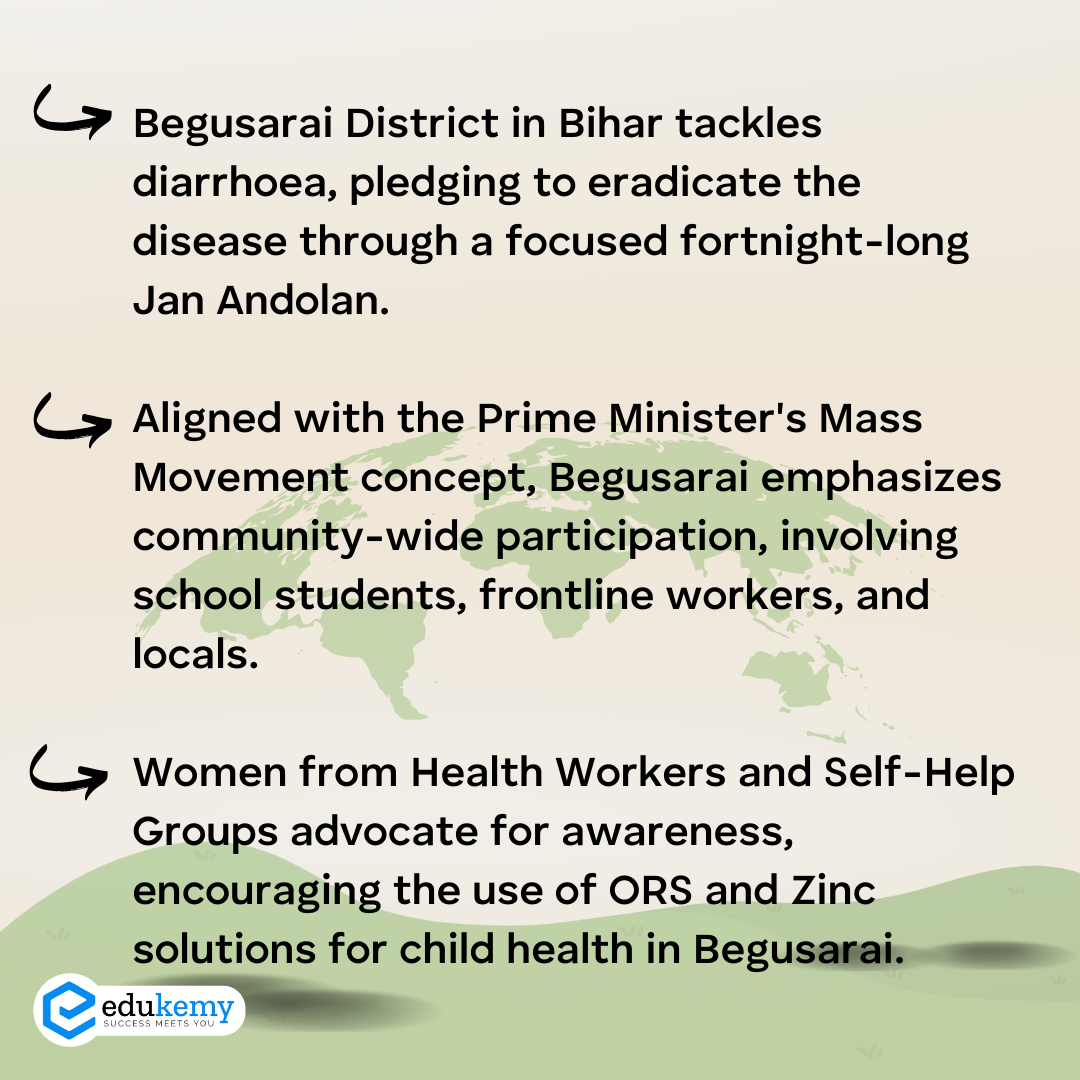
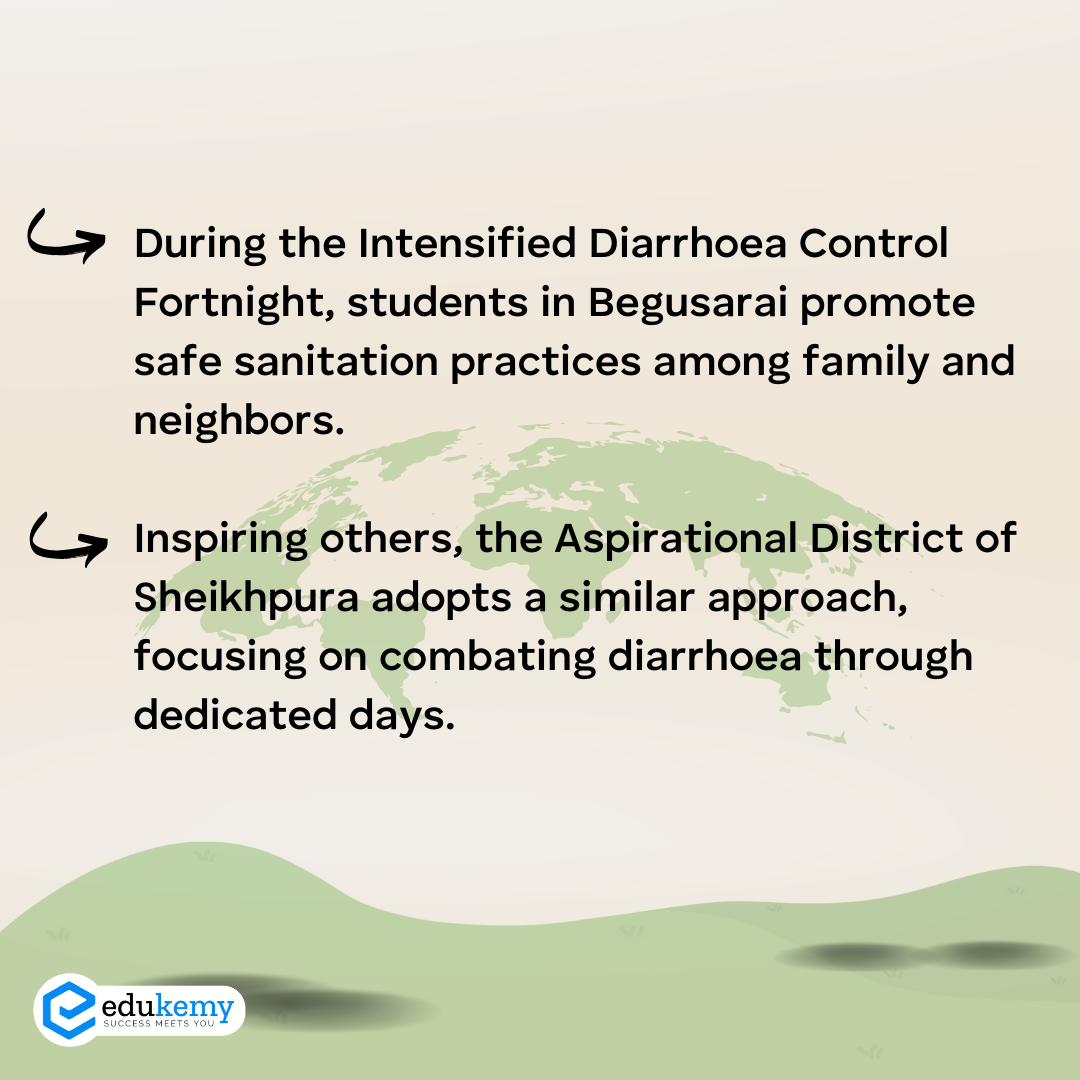
Share the article
Edukemy’s Current Affairs Quiz is published with multiple choice questions for UPSC exams
MCQ
Get Latest Updates on Offers, Event dates, and free Mentorship sessions.

Get in touch with our Expert Academic Counsellors 👋
FAQs
UPSC Daily Current Affairs focuses on learning current events on a daily basis. An aspirant needs to study regular and updated information about current events, news, and relevant topics that are important for UPSC aspirants. It covers national and international affairs, government policies, socio-economic issues, science and technology advancements, and more.
UPSC Daily Current Affairs provides aspirants with a concise and comprehensive overview of the latest happenings and developments across various fields. It helps aspirants stay updated with current affairs and provides them with valuable insights and analysis, which are essential for answering questions in the UPSC examinations. It enhances their knowledge, analytical skills, and ability to connect current affairs with the UPSC syllabus.
UPSC Daily Current Affairs covers a wide range of topics, including politics, economics, science and technology, environment, social issues, governance, international relations, and more. It offers news summaries, in-depth analyses, editorials, opinion pieces, and relevant study materials. It also provides practice questions and quizzes to help aspirants test their understanding of current affairs.
Edukemy's UPSC Daily Current Affairs can be accessed through:
- UPSC Daily Current Affairs can be accessed through Current Affairs tab at the top of the Main Page of Edukemy.
- Edukemy Mobile app: The Daily Current Affairs can also be access through Edukemy Mobile App.
- Social media: Follow Edukemy’s official social media accounts or pages that provide UPSC Daily Current Affairs updates, including Facebook, Twitter, or Telegram channels.

